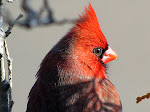I learned early on that summer vegetation and foliage poses problems, creates obstacles when it comes to bird photography. It is so much easier to get well-lighted, unobstructed views of birds in November than it is in June; but November's birds aren't June's birds, and the challenge, the essence of bird photography is to take advantage of opportunities within environmental situations as they present themselves.
It was a clear, sunny day, but it was hot: really hot. The temperature was already in the low to mid eighties with sunrise, and rose to the low to mid nineties by noon. Thus, just as I frequently did during the day, the birds smartly took to the shade.
Consequently, the shadows wreaked such havoc on the would-be quality of so many of my results that I am quite reluctant to even use the term quality in referring to what I would normally display as my top five quality photographs of the day. Accordingly, what follows are the five pictures of the day that I simply like the best.
1)
First of all, the spider webs and stuff hanging off his chin are my fault. This is the last of numerous pictures I took of this guy. Normally, he's not really afraid of me. He often walks the ground very close to me, foraging through the grass; and when I happen to get a little too close to him, he flies off to the lowest branch of a nearby tree. Just prior to capturing this image, I got really close to his preoccupied meanderings through the grass and made him fly through an area where neither he nor I would normally go. In fact, I got spider webs all over me too as my pursuit of him took me under the very low reaching branches of the tree in which he's perched.
I hope he forgives me.
Secondly, it took a lot of brightening up to get this picture to look as it does, so pay no attention to the nauseating background.
2)
The above image of a Barn Swallow doesn't look that bad, but it, too, required a lot of work—in real time and during the editing process—to get it to look as good as it does. The bird was under a canopy of leaves and at the end of what seemed like a tunnel of foliage.
3)
The above Tufted Titmouse just came down and started walking around on this picnic table which was adjacent to the one where I was sitting, taking a break in the shade. I very, very slowly raised my camera and squeezed off this pic. It, too, took a lot of brightening up to get it to look as it does.
4)
The above pictured Green Heron was my aforementioned pleasant and fortunate surprise. I hadn't seen it since the tenth of June, and I wasn't expecting to see it again this year; but there it was, making all kinds of noise and making sure I saw it. I got six shots of it, and this one was the best. In fact, it turned out to be the best quality photograph of the day.
Were I displaying, my top five best quality photographs of the day, this one would be number one; however, I'm displaying my top five favorite captures of the day. Seeing the Green Heron and getting the above image was like a wonderful, unexpected gift given to me by Nature. Photographs one, two, and three, however, required a lot of effort that turned out rather successful. Moreover, how often does one get up five feet from a Red-winged Blackbird with spider webs stuck all over it, how often does one get up twenty feet from a Barn Swallow perched and preening on a limp in the shade, and how often does one have a Tufted Titmouse join them for a break in the shade at an adjacent picnic table?
And then, there's my friend below who decided to show me what it looks like when one sings with feeling. This capture should probably be number one, but as in American Idol, the judges sometimes get it wrong.
5)
The four syllable song it was singing was similar to the sound track featured in this site, but his was much more bold and forceful.
So much for my five favorite pics of the day. What follows, in time line order, are the next one dozen pics that I found favorable.
Just to reiterate a phenomenon of the day, in getting all of the below displayed pictures, expect for the immediately below American Goldfinch (whose eyes cannot be clearly seen), I was dealing with birds in shadows, birds under thick foliage, birds in the shade.
I kept clicking and waiting for the above Red-winged Blackbird to come out of the shade and get into the sunlight. This was as good as it got. I feel that this photograph turned out pretty good. It required little editing, and I like the little lavender flower up near the left corner. However, the stark contrast between the sunlight and the shadow—as well as the out-of-focus near background—is a bit disconcerting to my eyes.
If I were reading his mind correctly, he was kindly telling me to leave him alone. I didn't: at least not for a few more minutes. Remember one and five of my favorites of the day?
I hope he forgives me.
I hope he forgives me.


















_edited-1.jpg)
_edited_1.jpg)
_edited-1.jpg)
_edited-1.jpg)
_edited_1.jpg)






















